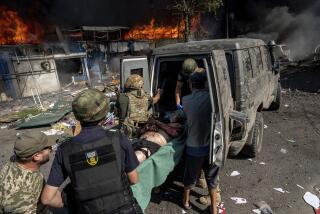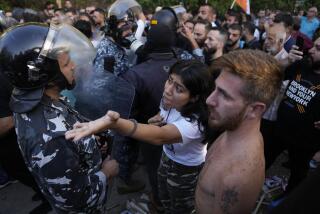Social Conflict in the Soviet Union
- Share via
MOSCOW — Riots in Kazakhstan in December, 1986, demonstrations by the Crimean Tartars in Moscow, marches in the Baltic region in 1987-88, isolated incidents in Yakutia and Uzbekistan, rising activism by the Russian “patriotic” society Pamyat, the continuing emigration from the Soviet Union of Jews and ethnic Germans and, finally, the developing conflict now between Azerbaijan and Armenia--all these events point to the sharpening of national problems in the Soviet Union. The connection between them and national perestroika-- restructuring--is evident. Only public openness and democratization will allow better understanding and expression of many of the nationalist problems that have accumulated in our country over the past decades.
Liberalization of the regime and easing of the authoritarian, bureaucratic press has also unplugged some not exactly crystalline sources of pent-up dissatisfaction by causing, or at least aggravating, arguments and discord that existed before but did not look so serious against a background of overall injustice under a corrupt leadership. By calling on people to manifest social activism, to take part in solving political and other problems, Soviet leader Mikhail S. Gorbachev involuntarily encourages them to the kind of activism that hundreds of thousands of Armenians showed in the capital city of Yerevan, demanding a satisfactory solution of the Nagorno-Karabakh issue.
This is not our main ethnic problem, but it is a difficult one, with roots reaching far back over the centuries. When Nagorno-Karabakh was incorporated into Russia in 1813, it was a small Persian kingdom populated by Armenians. After the fall of the Russian Empire in 1917, the area, known as the Transcaucasian region, became the arena for both civil and bloody ethnic wars. One of the latter was the war between Armenia and Azerbaijan for possession of the Nagorno-Karabakh district.
Establishment of Soviet power in the Transcaucasian region ended those bloody conflicts, which in some localities caused a loss of from 10% to 30% of the population. During the subsequent delineation of borders between Armenia and Azerbaijan, in 1923, several districts with Azerbaijani majorities were transferred from Armenia to Azerbaijan, forming the Nakhichevan Autonomous Republic. But Nagorno-Karabakh, with more than 90% Armenian population, stayed within Azerbaijan, receiving only the status of an “ethnic district.”
Unfortunately, the facts of discrimination against Armenians there were numerous. Over the years of Soviet rule, Armenia’s population grew threefold, Azerbaijan’s slightly more than twofold, whereas in Nagorno-Karabakh there was insignificant population increase, and only in the Azerbaijani area. In 60 years, the overall number of Armenians there has shrunk from 142,000 to 136,000, a decrease from 94% to 76% of the population.
Armenians have suffered economic and cultural deprivation--they cannot even watch TV broadcasts from Yerevan today. The Armenian grievances--along with those of Azerbaijani Muslims--were steadily ignored both by Baku and Moscow, causing legitimate dissatisfaction among Armenians, who were the first victims of genocide in the 20th Century. Thus their particularly sharp reaction now to all forms of ethnic injustice should not be surprising.
In the Western press one often comes across the claim that friendship between peoples in the the Soviet Union is a myth, created by Soviet propaganda. That is an erroneous judgment. More than 100 nationalities live in the Soviet Union and their cooperation in economy and culture, their mutual respect and friendship are not mythical. Creation in the Soviet Union of the new historical, social and internationalist entity, which is usually described as the “Soviet people,” is a reality. My father, for instance, is ethnic Russian; my mother is a Jew. I married a Ukrainian woman and my son recently married an Armenian. On holidays, friends come to my place and in their passports they are registered as Georgians, Estonians, Azerbaijani. This is not a myth but a reality of our life.
However, the claim that there are no ethnic conflicts in the Soviet Union is a myth--and a pernicious one, too. These conflicts do exist and their number grows. As is known, the ethnic issue has always occupied an extremely important place in the Marxist-Leninist ideology, which is only natural for such a country as the Soviet Union, with its national problems. All Russian revolutionary parties recruited supporters from the “minorities,” but the Bolsheviks, with their ethnic program, succeeded more than others. Without the support of Latvians, Estonians, Finns, Poles, Georgians, Armenians, Jews, Ukrainians, Tartars, Germans from Volga and Crimea areas, Chechens, Bashkirs, even Hungarians and Chinese, the Bolsheviks would never have won their war and created the Soviet Union.
In the 1920s there was great attention paid to ethnic problems; they were discussed at almost every party congress. There were certain mechanisms for studying and resolving ethnic conflicts. In the early 1930s, however, Josef Stalin announced that the ethnic issue had been resolved, “exhaustively and finally,” in our country, and that Soviet culture, “ethnic in form, but socialist in essence,” had been created. Since then our press has been writing almost exclusively about friendship between the Soviet peoples and we no longer have the mechanisms for researching ethnic conflicts. But there are sufficiently powerful organizations to combat “bourgeois nationalism,” and those forces have proved one of the causes behind the current worsening in ethnic relations in the Soviet Union.
The Soviet press writes about “normalization of the situation” in Karabakh and Armenia but the problem has not been solved. It has been put on the back burner and even further aggravated, as the tragic events in the Azerbaijani city of Sumgait showed.
Unfortunately, among the victims was glasnost --a situation almost like the first 10 days of the Chernobyl catastrophe. We cannot read in our newspapers about the demonstrations in Yerevan, about the visits there by such Soviet leaders as Central Committee Secretary Vladimir I. Dolgikh, Secretariat member Georgy P. Razumovsky or former Minister of Culture Pyotr N. Demichev. We have not even read Gorbachev’s appeal to the peoples of Armenia and Yerevan, as well as accounts of his meeting with the Armenian intellectuals. We know nothing about a statement by the religious leader of all Armenians, just as we know nothing about the “riots” in Sumgait.
Do the ethnic developments of the last two years represent any threat to Gorbachev’s prestige and policies? Of course. They are a serious test for the current policy of reforms. In this case, Moscow acts as arbiter in a difficult argument, and this is a trial for the leadership’s ability to arrive at a just and reasonable solution of a problem that Gorbachev inherited, but which must be resolved today.
In my opinion, the people in Nagorno-Karabakh must hold a referendum, provided for such occasions by the constitution of the Soviet Union. Then its outcome must be discussed by the Supreme Soviets of Azerbaijan and Armenia. If they disagree, a special session of the Supreme Soviet of the Soviet Union--or its nationalities chamber--must be held, with the most thorough presentation of the problem.
Perhaps Soviet leadership will find other ways to a solution; we will soon know. I am still worried by the shortage of information and openness concerning such portentous events in our country. But I continue to hope that a reasonable solution will be found for all existing and budding ethnic problems, as well as for glasnost and democracy. This will mean progress in restructuring, not its defeat.
More to Read
Sign up for Essential California
The most important California stories and recommendations in your inbox every morning.
You may occasionally receive promotional content from the Los Angeles Times.










